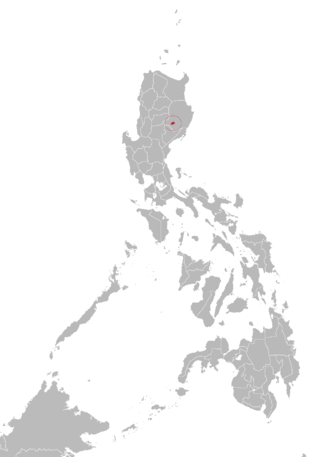Yogad language
| Yogad | |
|---|---|
| Native to | Philippines |
| Region | Luzon |
Native speakers | (16,000 cited 1990 census)[1] |
| Language codes | |
| ISO 639-3 | yog |
| Glottolog | yoga1237 |
 Area where the Yogad language is spoken | |
Yogad is an Austronesian language spoken primarily in Echague and other nearby towns in Isabela province in northern Philippines. The 1990 census claimed there were around 16,000 speakers.[2]
Classification
Anthropologist H. Otley Beyer describes Yogad as a variant of Gaddang language and the people as a sub-group of the Gaddang people in his 1917 catalogue of Philippines ethnic groups.[3] Glottolog presently groups it as a member of the Gaddangic group; in 2015, however, Ethnologue placed Yogad as a separate member of the Ibanagic language family. Godfrey Lambrecht, CICM, also distinguished separately the peoples who spoke the two languages.[4]
Alphabet
The Yogad alphabet has 21 letters composed of 16 consonants and 5 vowels.[5]
| Majuscule Letter | A | B | K | D | E | F | G |
|---|---|---|---|---|---|---|---|
| Minuscule Letter | a | b | k | d | e | f | g |
| IPA | /a/ | /b/ | /k/ | /d/ | /ɛ/ | /f/ | /ɡ/ |
| Majuscule Letter | H | I | L | M | N | NG | O |
| Minuscule Letter | h | i | l | m | n | ng | o |
| IPA | /h/ | /i/ | /l/ | /m/ | /n/ | /ŋ/ | /o/ |
| Majuscule Letter | P | R | S | T | U | W | Y |
| Minuscule Letter | p | r | s | t | u | w | y |
| IPA | /p/ | /ɾ/ | /s/ | /t/ | /u/ | /w/ | /j/ |
References
- ^ Yogad at Ethnologue (18th ed., 2015) (subscription required)
- ^ "About Yogad". Yogad Kan.https://www.yogadkan.com/about-yogad.html
- ^ Beyer, H. Otley (1917). Population of the Philippine Islands in 1916 (población de las islas Filipinas en 1916) (in English and Spanish). Manila: Philippine Education Co., Inc. p. 22.
- ^ Lambrecht, Godfrey (1959). "The Gadang of Isabela and Nueva Vizcaya: Survivals of a Primitive Animistic Religion". Philippine Studies. 7 (2): 194–218. JSTOR 42719440.
- ^ Yogad: First Primer. The Summer Institute of Linguistics. 1956.
- Davis, Philip W.; Mesa, Angel D. (2000). A Dictionary of Yogad. Munich, Germany: Lincom Europa.
